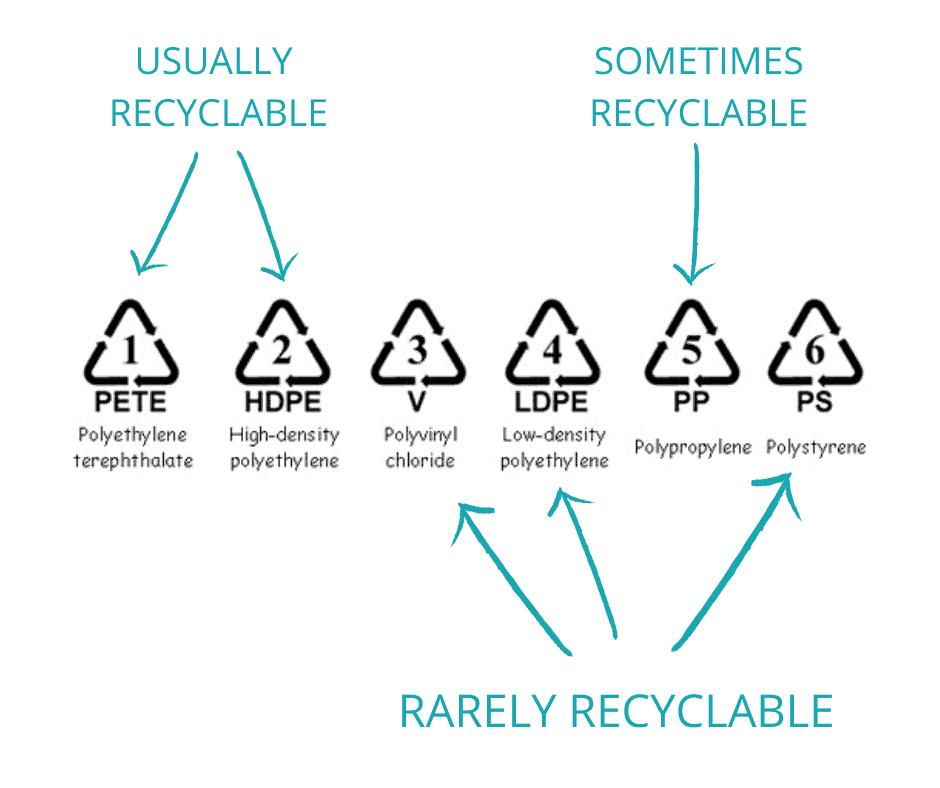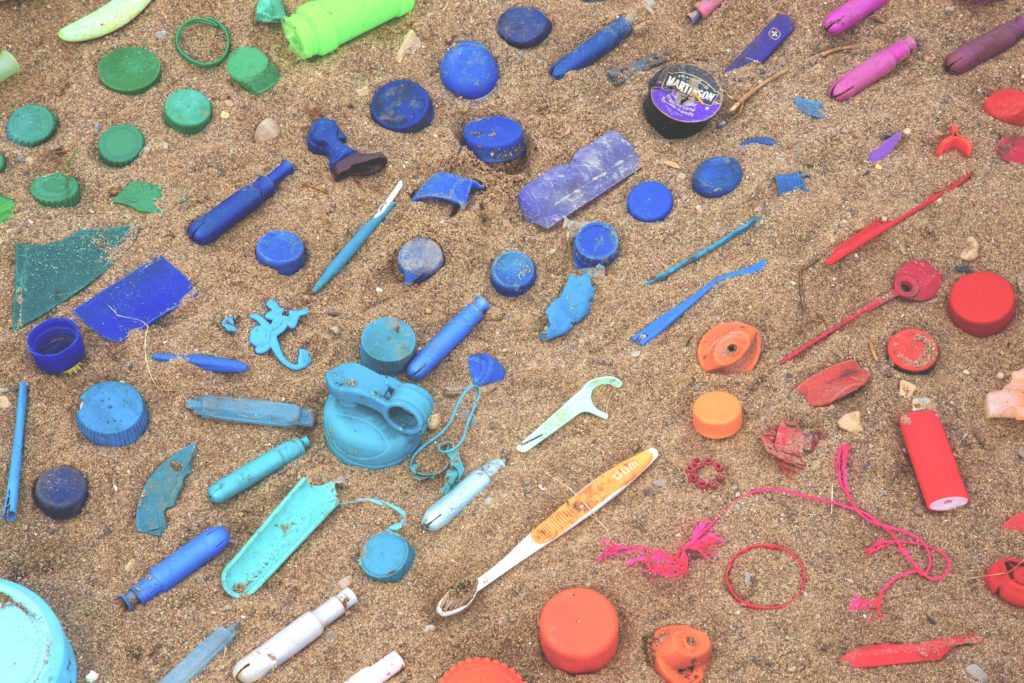One thing is for sure, with a world population of 7.8 billion people we can’t continue consuming plastic as we are.
On average, Australians use 130 kg of plastic per person each year. Only 12% of that gets recycled. Up to 130,000 tonnes of plastic will find its way into our waterways and the ocean. Sadly most plastics are made to be used once before being discarded. (Source: WWF)
Where does empty packaging end up?
Every time you use an item like shower gel think about this – before you picked it up, that bottle was created in a factory (using energy and resources and emitting carbon) filled, then transported (using more energy and resources). Once you buy it and use up the contents there are usually three options for where the bottle ends up, none of which are very sustainable:
1. Recycling. Most of us think we’re doing the right thing by recycling, but the truth about where it ends up is shocking and murky. If the empty bottle actually makes it to be recycled, the recycling process uses resources and carbon emissions to transport, process, then reform it. Most sources show a worrying lack of real infrastructure to deal with recycling since China stopped accepting it in 2018.
Some materials like metal and paper have fairly high recycling rates, but shockingly only 12% of plastic actually gets recycled due to issues with contamination. (Source: ABC) Furthermore, many plastic types can’t be recycled. The well-recognised “chasing arrows” symbols on plastic containers (below) do not mean it’s recyclable. The number inside the triangle indicates the plastic type, and some can’t be recycled depending on the local council.

2. Landfill. If the bottle isn’t recycled then it ends up in landfill or gets sent abroad. Many items intended or expected to be recycled have this fate as far fewer plastic types are recyclable than we realise.
Most of Australia’s plastic rubbish ends up being stockpiled in warehouses or shipped to South-East Asia to be illegally burned, polluting local communities by emitting chemicals into the air, soil and water systems.
3. In the ocean or elsewhere in nature. Billions of empty bottles end up floating in the ocean with tonnes of other plastic, killing marine life, leaching chemicals and washing up on beaches.
The way we use everyday products clearly needs to evolve. There are already some great closed loop solutions coming onto the market globally.
 What’s the solution to plastic waste?
What’s the solution to plastic waste?
There are several exciting sustainable packaging approaches appearing on the market. The best easily scaled solutions are refilling and reusing durable non plastic bottles and containers, and degradable and dissolvable packaging.
Biodegradable and water soluble packaging is one of the most promising novel solutions with some amazing companies offering truly sustainable products such as water soluble corn-based padding instead fo polystyrene.
But not all ‘degradable’ options are what they seem as unfortunately many supposedly ‘biodegradable’ materials either don’t fully disintegrate, or only properly degrade in specific conditions which they aren’t likely to reach (such as if they are put into a proper composter). I won’t go into degradable packaging here as it needs its own article!
As we adapt to new more sustainable ways of consuming, consumers need to be eased in with relatively convenient, appealing and cost-effective solutions that take us in the right direction.
 Refills are the future
Refills are the future
For years I’ve thought the most viable approach to using everyday products sustainably is to refill them. Yet refills still aren’t common for most products. Encouragingly, refillable products are gaining momentum in the last year or two with some shops selling solely refillable goods, although these are mainly only store cupboard foods at this stage.
A few businesses are offering refills for products other than dry foods such as deodorant and laundry detergent in Australia and beyond, but it hasn’t yet been adopted widely.
There’s a growing zero waste trend, but most businesses aren’t keeping up. Reusable ‘keep cups’ for coffee are increasingly popular, saving lots of disposable coffee cups from landfill, which is really encouraging to see. It shows people can and will adopt new behaviour to avoid waste. Now we need reusable and refillable options for all product types!
Why aren’t refills more mainstream?
Let’s be honest, most of us are busy. People generally buy for convenience and price. Offering refills can be complex and expensive for the companies selling the products, as I know from experience. But we seem to be moving in the right direction, slowly.
 We need to move away from plastic
We need to move away from plastic
A move away from plastic as a material is clearly needed in order to kick the plastic waste problem – even if it’s refillable. Recycled / reformed plastic is a temporary solution for some product types as we transition away from plastic. But recycled plastic isn’t a viable long term solution when plastic is what we’re trying to get away from. Plastic in the ocean is plastic in the ocean.
Non-plastic packaging like glass and aluminium are best suited for reusable and refillable products as they are more durable and don’t deteriorate or scratch like plastic does. Glass doesn’t stick around as long as plastic in its post-useage lifespan. If glass does end up in the ocean it breaks down eventually as it’s made from silica (sand).
My refillable skincare business Azur Pure Skincare uses refillable glass and aluminium bottles. They’re all intended to be reused. In future I plan to find a non-plastic pump to dispense the products, but haven’t found one that’s fully metal anywhere. (the straw and inner workings are always plastic) So I’m taking a step by step approach for now.
Purchase and disposal habits need to change
Most people buy disposable products – such as shampoo in single-use plastic bottles – then once used up simply throw the empty containers into the recycling or landfill bin. This is the big habit that needs to change.
Refillable products are still very much in the minority. Australia has some great bulk stores with refill options, which sell mostly dried store cupboard foods and sometimes a few limited skincare products such as castile soap. One of the reasons I started my business is because I couldn’t find a good mild organic wash or moisturiser that was refillable and not packaged in plastic. These bulk and refill stores and the products they sell are in the minority sadly, and supermarket brands don’t offer refills yet.
Financial incentives such as a deposit scheme or discounts can encourage people who are less environmentally minded to make the extra effort to send back or refill once their products run out.
The habit of refilling isn’t yet part of people’s lives. But it could be – just look at how refillable milk was common for decades in many countries around the world. When I was a kid in the 80s / 90s in England the ‘milkman’ (I assume there must have been milkwomen too!) delivered glass bottles of milk to most people’s doorsteps early each morning on an electric milk float. Milk was fresh from the farm. This stopped in the 90s when most people switched to buying cheap homogenised milk in large plastic bottles from supermarkets.
At Azur Pure Skincare we’ve been trialling refillable wash and moisturiser products for a while now. Customers are enthusiastic and love the concept but it’s not easy to get everyone to refill yet. We’ve trialled a few options – refills at markets, large bulk refills and free bottle returns. The simplest and most popular is our prepaid post return service for empty bottles.
How do refills work?
There are various ways refills can work, depending on the product. In this case I’m focusing on everyday skincare and shower products like wash and moisturiser, and similar liquid products.
1. Bottle returns
Returning empty bottles to the producer. This option requires effort on the customer’s part, so needs to either be incentivised with refunds or discounts, and / or with a reply paid freepost label so they can quickly be dropped in post boxes. The returned bottles can then be sanitised in batches and re-used. This is the refill option we’re focussing on at Azur, as it’s most convenient and easy for customers.
2. Refill pouches
This option is only sustainable if the refill pouches / containers can be sent back and reused, or if they are made from truly biodegradable or compostable material. Unfortunately such materials aren’t generally suitable for use with liquids as most disintegrate quickly when they contain liquids. (If you know of a sustainable refill pouch please let me know!) Pouches for liquids are always plastic or have a plastic layer to make them waterproof, even if they look like foil externally.
3. Bulk refills
Larger bulk refill bottles can save on resources and shipping, depending on when the product will expire. This option works for Azur wash which is quite easy to pour, but the face moisturiser is too thick for a customer to easily decant into a new container with a special refill machine.
4. Refill machines
Refilling machines or stations in stores are great solution which I hope will become more widespread for a range of products. The manual refill machines we’ve sourced for Azur Pure Skincare products are really fun to use, like Mr Whippy ice cream machines! This option usually relies on customers going to a shop to refill. Some businesses offer refills by car or van which is an exciting idea, especially with electric vehicles.
A sustainable future needs closed loop systems
These are exciting times as the world and customer expectations are changing rapidly. I see a shift to more innovative and circular systems where businesses take responsibility for their own packaging, alongside a shift to more healthy and natural product choices with non-plastic materials like wood, metal and glass making a comeback.
My vision with Azur Pure Skincare is to provide quality closed-loop, inspiring, natural organic products that are also convenient.
What do you see for the future of packaging? Which is your favourite option? Let me know in the comments below!


